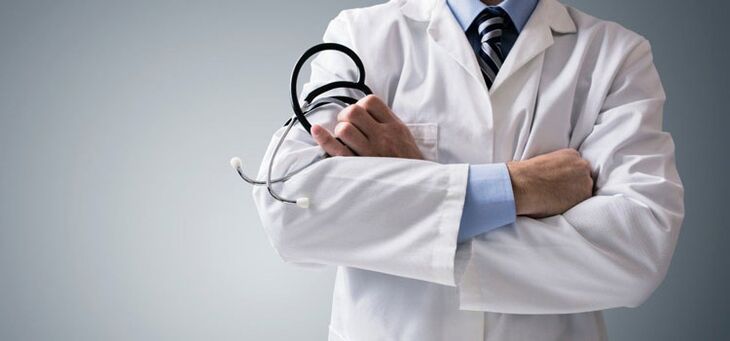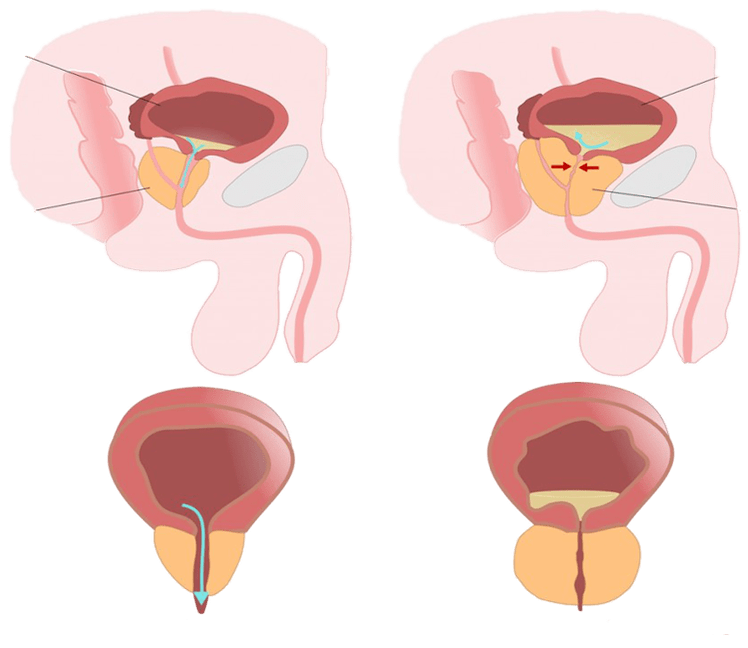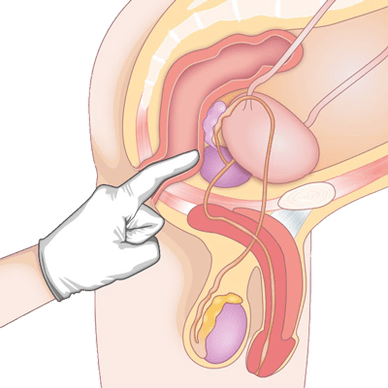
Diseases of the reproductive system in men are difficult to treat and have a recurring nature. Prostate diseases affect hormone levels, emotional state, erectile and urinary function.
Treatment of prostatitis in men is complicated by the fact that in the early stages of development, the disorder practically does not manifest symptoms. The first signs appear as the disease progresses. Early diagnosis and a fully prescribed treatment course are the keys to a favorable prognosis in the fight against pathology.
What is prostatic disease
With a few exceptions, the term "prostatitis" refers to chronic or acute inflammation of the prostate. Symptoms of prostatitis in men are similar to symptoms of other diseases of the genitourinary system. This process leads to blockage of glandular tissues and the appearance of the following disorders:
- Dysuric disorders.
- Reduced sexual desire.
- Erectile dysfunction.
- Pain syndrome.
The disease causes the formation of adhesions and scars. Metabolism and blood circulation in tissues gradually worsen. Irreversible changes that occur can only be corrected through surgery. There are several types of the disorder depending on the cause and stage of development.
Classification of prostatitis
Prostatitis develops based on congestion in the pelvic area. This process quickly becomes chronic. The favorable time for treatment is the early stages of the disease.
Medical reference books describe 4 types of diseases, with characteristic symptoms and manifestations:
- Type I—Acute prostatitis.The catalyst is an infection that has penetrated the tissue, causing damage and hypothermia of the gland. Inflammation occurs suddenly and lasts 3-4 days. Without necessary therapy, it will become chronic. Expression:
- heat,
- fever,
- pain in the pelvis and lumbar region,
- body poisoning.
- Type II—Chronic bacterial prostatitis.It started with an exacerbation. Reason for appearance: interrupted course of antibiotics, self-medication. Inflammation occurs in a latent form, with no obvious manifestations, until the immune system is weakened to the point that infection causes the disease to become more severe. Treatment begins with antibiotics and NSAIDs.
- Type III—Chronic prostatitis/chronic pelvic pain syndrome (CP/CPPS).A mutated disease caused by acute prostatitis. The disorder develops slowly, irreversible changes occur leading to tissue obstruction. In contrast, congestive inflammation is divided into two subgroups:
- Type IIIa - Chronic prostatitis/chronic pelvic pain syndrome with signs of inflammation.It is characterized by pronounced manifestations: mild fever, increasing with exacerbation to 38-38. 5°. Typical symptoms of male prostatitis: erectile dysfunction, bleeding, prolonged sexual intercourse without orgasm, difficulty urinating.
- Type IIIb - Chronic prostatitis/chronic pelvic pain syndrome without signs of inflammation.In this case, the manifestations are diagnosed exclusively by instrumental research methods.
- Type IV—Chronic asymptomatic prostatitis (no symptoms).It is considered a poorly understood disease whose cause is not fully understood. Some leading urologists have suggested an age-related cause. There are no medical symptoms.

It is difficult to cure prostatitis even in the early stages. To achieve stable remission, it is necessary to eliminate the causes - catalysts, deal with complications and consequences that arise.
Why is prostatitis dangerous?
Prostatitis is a serious disease that affects men's health. Possible complications and consequences of the disease:

- erectile dysfunction- scarring and adhesions, the result of inflammation, prevent normal blood flow in the cavernous vessels. At the same time, the prostate's ability to process testosterone declines. Reduced sexual desire. During the acute phase, friction and ejaculation bring painful sensations. All of the above cause a decline in erectile ability. In some cases, complete sexual impotence is diagnosed.
- Dry— chronic inflammation that affects not only the prostate but also spreads to neighboring parts and organs of the genitourinary system. Usually degenerative disorders manifest in ligaments: testicles + glandular tissue. Sperm quality and quantity decline. Pregnancy from a man with advanced prostatitis is a problem.
- Development of related diseases- inflammation can spread to neighboring organs of the genitourinary system:
- urethral tube,
- bladder,
- kidney,
- scrotum
- Death- the risk of death exists with a purulent disease. If treatment of acute male prostatitis is not started on time and pus develops into an abscess, the patient's life will be in danger. A ruptured cavity towards the rectum leads to general intoxication and can lead to death.
In severe conditions, surgery is required. Unlike adenomas or malignant hyperplasia, surgery is extremely rare and does not guarantee prevention of recurrence.
Which doctor treats prostatitis?
It all depends on the manifestations of the disease. The urologist is still the main person. It is this specialist who deals with pathologies of the male reproductive system, including prostatitis. In case of some violations, another specialist must be consulted.

Current clinical guidelines indicate the need to promote:
- Psycho doctor— need help if pain and other manifestations create sexual refusal or impotence without physical disorders.
- Immunologist- antibacterial treatment and long-term medication cause a strong blow to the body. Protective functions and resistance to infection are reduced. Some forms of prostatitis begin with autoimmune diseases. In each of these situations, the assistance of an immunologist will be needed.
- Operated doctor- Open purulent abscesses, perform TUR, remove the prostate and remove calcifications by a specialist. A surgeon's help is needed to remove adhesions in the vas deferens and restore reproductive function.
The number of such specialists needed to completely heal the patient convincingly proves that it is impossible to cure prostatitis on your own, let alone get rid of complications. Qualified support is required.
How to recognize prostatitis
The insidiousness of this disease lies in the fact that, for a long time, inflammation develops in a latent, asymptomatic form. The first signs of prostatitis are often due to: fatigue, radiculitis, diseases of the genitourinary system. The pain stops after taking painkillers or antispasmodics. But prostatitis continues until the disorder becomes global. A man went to the doctor and received an unpleasant diagnosis.
However, the most effective way to get rid of prostatitis is early diagnosis and immediate treatment. The chance of complete recovery is about 80%.
To distinguish inflammation from other diseases, several diagnostic tests are performed:

- Rectal method— the doctor probes the structure of the gland by inserting a finger into the anus, allowing to identify any abnormalities and deviations.
- Ultrasound and TRUS— Ultrasound diagnosis remains the standard of study due to its low cost and availability. The screen shows the loose structure of the gland, indicating inflammation, and can detect calcification and other signs of prostatitis.
- Clinical and biochemical tests of blood and urine- shows the presence of inflammation, and also identifies the infectious agent.
- Spermogram- Reduced vitality and speed of sperm, a characteristic sign of congestive prostatitis and congestion of glandular tissue. Bacteria and pathogens are found in semen during infectious diseases.
- MRI and PET-CT- the most reliable diagnostic method. Due to the high cost, examination is indicated only if the results of previously performed tests are unclear, as well as if cancer is suspected.
CT scan showed signs of early-stage prostatitis, which could not be achieved by other diagnostic methods. If abnormalities in prostate activity are suspected, MRI remains the preferred instrumental examination method.
How long does it take to treat?
Stories about miraculous liberation in a few days are nothing more than fairy tales. There is no quick way to treat prostatitis. After diagnosing inflammation, you need to adjust your long-term therapy and make radical changes in your eating habits and lifestyle. Only in this case can the disease be defeated.
Modern and effective prostatitis treatment methods have helped shorten treatment time. With an integrated approach, significant improvements can be achieved within 2-3 months.
Doctors have learned to cope with the consequences of prostatitis. Unique treatment methods help eliminate infertility, restore normal erections and increase sexual desire.
Once the disease is in stable remission, you will have to regularly take herbal medicine, attend physical therapy sessions for prevention, and maintain men's health in other ways.
How is prostatitis treated?
There is no effective pill, after taking it all unpleasant symptoms will disappear. In traditional medicine, there is no such miracle cure. The best treatments for prostatitis in men with proven effectiveness include combined methods: medication + physical therapy + unique methods.
Official medicine offers conservative treatment methods. After completing the course, unpleasant symptoms and negative manifestations of the disease will disappear. At the second stage, the task is to eliminate the complications that have arisen.
Advanced non-invasive methods have increased the chances of achieving a favorable outcome of the disease. Surgery is necessary in no more than 10-15% of cases.
With the help of medication
Conservative therapy is aimed at eliminating symptoms. The following groups of drugs are prescribed:

- NSAIDs- Reduce inflammation, heat and fever. They have a mild analgesic effect. Once prostatitis begins, short-term treatment with anti-inflammatory drugs and vitamins is required to maintain the gland in its normal state. The drug is available in the form of suppositories, tablets and injections.
- Antibiotics- designed to eliminate inflammatory or bacterial factors. The treatment regimen for prostatitis is prescribed after the pathogen has been identified and its antibiotic resistance has been tested. The course of treatment is 7-10 days. In severe cases, treatment is extended to two weeks.
- Hormonal- is recommended if conventional medication does not bring any benefit, as well as decreased sexual desire due to disease progression. Hormone treatment in the early stages is prohibited. The drug is administered under the close supervision of a urologist.
- Symptomatic medication- to eliminate pain, take acetylsalicylic acid tablets. Spasms are eliminated by an antispasmodic agent. For prolonged severe pain, blockade with anesthetics is indicated.
- Vitaminand medications to maintain prostate function. During remission, medications should be taken to normalize metabolism and improve blood supply to glandular tissues and juice production. For this purpose, herbal medicines are prescribed. To strengthen the immune system, a vitamin and mineral complex is prescribed.
Self-medication is very dangerous and does more harm than good. Before taking any medication, you should consult a urologist.
Use physical therapy
Prostatitis is characterized by extensive congestion in the pelvic area, which significantly complicates treatment. Taking the drug turned out to be ineffective, since the active ingredients simply could not be delivered through the blood vessels to the prostate.
To increase the effectiveness of drug treatment, immediately after remission, physical therapy is included in the treatment of prostatitis in men.
In addition to traditional electrophoresis, the following techniques are prescribed:
- UHF and microwave.
- Magnetic therapy.
- Mud therapy.
- Electroplate.
- Supersonic.
- Laser treatment.
- Heat therapy.
Most of the procedures listed are part of the set of techniques used in spa treatments. Contraindications to physiotherapy remain: acute inflammatory phase, tumor development, individual intolerance in the patient.
Natural remedies
Modern treatments for prostatitis increasingly combine orthodox methods with alternative medicine. In ancient times, our ancestors treated prostatitis with herbal infusions, decoctions and bee products. The disease itself was not cured, but the unpleasant symptoms were relieved.
Several methods have existed to this day:
- Drug therapy— beekeeping products are used to eliminate inflammation and strengthen the immune system. Honey is a natural antibiotic. Used to treat diseases: death, propolis, wax, pollen, poison. Compresses and massage with honey, tinctures are made.
- Herbal collection- urinary compounds are sold in pharmacies and you can prepare them yourself. Herbal medicine treats urinary disorders, reduces inflammation and relieves pain. Some plants have good antiseptic properties. Decoctions and teas are prepared from collections and added when preparing compotes and tinctures.
In the old days there were no hospitals or pharmacies. Illnesses are solved by using the gifts of "Mother Nature". After prescribing a course of medication, the urologist will certainly recommend one of the alternative drug recipes: herbal medicine or apitherapy.

Only an integrated approach to fighting prostatitis will help get rid of this disease once and for all. The success of treatment depends on early diagnosis and careful compliance with the urologist's recommendations.

























